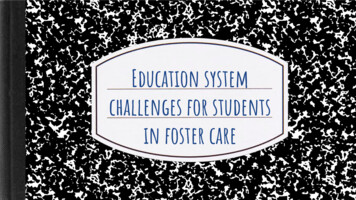
Transcription
Education systemchallenges for studentsin foster care
Participation andinteractionSound & volumeScreen SizeQ&A / ResourcesAssistance405-325-3221
3Hello!Meet Julia Sterr Programs Field Representative for EducationESSA State Point of ContactChild Welfare Services-Oklahoma Department of Human Services
Education services and developmental disabilities unit4Meet the Team Darla Hill-MyersPrograms Supervisor Shannon WatiePrograms Filed Representative, Developmental Disabilities Eric LondonPrograms Field Representative, SHIELD Melanie MoorePrograms Field Representative, Developmental Disabilities Marquita “MJ” Major Child Welfare Specialist III, Developmental Disabilities
5Education services—What we doObtainschoolrecordsLiaison-OK Regents ofHigher Ed-OK’s PromiseScholarshipPoint of Contact-ESSA-OSDEProvidetrainingAssist &supportCreate &AmendPolicyCoordinateeducationalresources
6Understanding two systemsEducationChild Welfare
7Barriers for students in foster care*Research Highlights on Education and Foster Care, January 2014Placement stabilityInadequate level of educationEmotional factors Change schools anavg. of 3 times 2-3 times more likelyto have disabilities Lack of support &separation from family Lose an avg. of 4-6months progress Schools fail to identifyspecial needs High mobility decreasedstability in relationships Ability to focusprofoundly impacted Oftentimes unable tocomplete assessments Survival mode
8Education for all studentsIDEA(1990, 2004)Section 504of theRehabilitation Act (1973)Every Student Succeeds Act (2015)No Child Left Behind (2001)Elementary and Secondary Education Act (1965)
Every student succeeds act 2016--highlightsEnrollment without delayAbility to remain in school of best interestCreates points of ter-care-state-plan-memo9
Education compact for students in state care act10Timely transfer and/or enrollmentExpedited exchange of recordsWaives requirements of records for enrollment(NEW) Automatic enrollment in CORE curriculum(NEW) Ability of schools to waive school-based graduation requirements
DHS Policy-schools/education (340:75-6-50) Home School Private School Records Surrogates Updates to the Courts11
12The School years Sooner StartAges 0-3Early Head Start / Head StartAges 0-5Preschool(Student must be age 4 by Sept. 1 for public Pre-K)Students can be assessed for Special Education beginning at age 3 Elementary School(Student must by age 5 by Sept. 1 for Kdg.) Middle SchoolHigh SchoolPost-Secondary Resources
13Soonerstart Children age 3 and younger--Form 04MP053E-children IN custody--Form 04MP052E-children NOT in custody Foster parents areresponsible for participating SoonerStart will contactfoster parent to completeassessment(evaluation/services)340: 75-3-500 ITS (3) ITS #6 (CPS)340: 75-4-12.1 (i) ITS #11 (FCS)340: 75-7-37 (c)(11)
14Making a soonerstart referral Include:TASSC ScreenerMedical InformationChild Welfare InformationCWS ObservationsParental ConcernsHistory GatheredFoster Parent/Caregiver InformationEtc.Have we told the parents?Have we discussed with thefoster parents or caregiver?Are there any safetyconcerns with parentalparticipation?
15Early head start / head start(and Educare in Tulsa and Oklahoma Counties) Children age 5 and younger--Ages 0-3 typically home-based--Ages 3-5 center-based Free & children in care takepriority on waiting lists Smaller class sizes More teacher training Transition to public school
Early Education-School readiness / additional optionsPublic al-educationChild Guidance Centershttps://www.ok.gov/health/Family Health/Child Guidance Service/Child Guidance Program/index.htmlChild Care Warm Linehttps://www.ok.gov/health/Family Health/Child Guidance Service/Child Care Warmline/index.htmlDHS Child Behavioral Health oac340075140001000.aspx16
17Types of school placementsTraditional Setting(Public Schools)Home SchoolingCharter SchoolAlternative SchoolOnline CharterPrivate School
Best interest determinationSchoolReceiving PreviousofSchoolSchoolOrigin18
Best interest determinationWhich school does thewill better meet theSTUDENTPREFERSOCIAL /EMOTIONALNEEDS &CHALLENGESto attend?of the child?will better meet theACADEMICNEEDS &CHALLENGESof the child?does theCAREGIVER orPlacement ProviderRECOMMENDthe student attend?19
Form 04MP072E Discussed and completed as a teamo Parento Foster parento Child Welfareo School*NOTEIf team cannot agree on school ofbest interest, Child Welfare makesthe final decision.20
Supporting documents Report Cards Progress Reports Achievement Data (test scores) Attendance Data IEP/504 Plans21
Mckinney vento actHomeless Children and Youth--NOT in DHS custody AND lacking fixed, regular, and adequatenighttime residenceChildren and youth “awaiting foster care placement” are no longerconsidered homeless under McKinney-VentoAll schools have a McKinney-Vento or “Homeless Liaison” for ChildProtective Services (CPS) and Family Centered Services (FCS) tocontact when a child’s schooling may be effected22
Credits and transcriptsGraduation RequirementsOklahoma’s Promise Req.On Track 6 credits per year23
Individualized career academic plan24
Individualized career academic plan25
Individualized career academic plan26
Oklahoma’s promise—tuition assistance program27 Complete application in 8th, 9th, or 10th grade Obtain all course requirements of OK’s Promise Maintain 2.5 GPA Stay out of trouble IN and OUT of the classroomEmail all applications to: cws.ohlap.oklahomapromise@okdhs.org Income requirements are waived for students in foster care Income requirements are amended for students adopted from DHS custody
Oklahoma successful adulthood program-education resourceshttps://oksa.ou.edu28
29
30Education for all studentsIDEA(1990, 2004)Section 504of theRehabilitation Act (1973)Every Student Succeeds Act (2015)No Child Left Behind (2001)Elementary and Secondary Education Act (1965)
31
32“To ensure that all children with disabilitieshave available to them a free appropriate publiceducation that emphasizes special education andrelated services designed to meet their uniqueneeds and prepare them for further education,employment, and independent living.”v 34 CFR § 300.1(a)
Child findThe school district is responsible for establishing and implementingan ongoing Child Find system to locate, identify, and evaluatestudents suspected of having a disability.This system applies to students, birth through 21 years, who mayneed special education regardless of the severity of the disability.The Child Find system includes all students within the schooldistrict’s geographic boundaries.33
34Eligibility categoriesDevelopmentalDelayAutism(IL, 3 to 9 years llectual Disability)EmotionalDisturbance (ED)(Anxiety, Depression, PTSD,HearingImpairmentMultiple DisabilitiesBi-Polar Disorder)OrthopedicImpairmentOther HealthImpairment (OHI)Specific LearningDisabilities(ADHD)(SLD or LD)Traumatic BrainInjuryVisual Impairment(TBI)Speech or LanguageImpairment(See 34 C.F.R. Sec. 300.8)
Timeline-Initial EvaluationDay 1Days 1-1045 days Request evaluation in writing School responds to request within 10 days If NO—you can appeal If YES—school has 45 days to complete the evaluation Student MEETS criteria—IEP generated Student DOES NOT meet criteria—NO IEP—can appeal35
36
37DisciplineFor up to 10 days, schoolpersonnel may suspendstudents with disabilitieswho violate the code ofstudent conduct to theextent that suchsuspensions are applied tostudents without disabilities.The school still has to providea Free Appropriate PublicEducation (FAPE) oropportunity to make progressin general education curriculumand towards IEP goals.
38“Don’t raise your voice,improve your argument.”--Tutu--
39
40Thanks!Contact MeJulia Sterr, Programs Field Representative for Educationcws.education@okdhs.org
CreditsSpecial thanks to all the people who made and released these awesomeresources for free: Presentation template by SlidesCarnival Photographs by Unsplash41
Email all applications to: cws.ohlap.oklahomapromise@okdhs.org. Oklahoma successful adulthood program-education resources 28 https://oksa.ou.edu. 29. Education for all students 30 IDEA (1990, 2004) Section 504 of the Rehabilitation Act (1973) Every Student Succeeds Act (2015)











